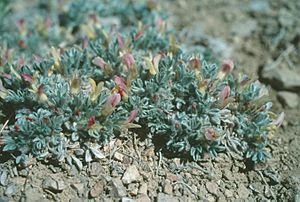Precocious milkvetch facts for kids
Quick facts for kids Precocious milkvetch |
|
|---|---|
 |
|
| Conservation status | |
| Scientific classification | |
| Genus: |
Astragalus
|
| Species: |
proimanthus
|
Astragalus proimanthus, also called the precocious milkvetch, is a special kind of flowering plant. It belongs to the legume family, which includes peas and beans. This plant is very rare. It grows in a small area in Sweetwater County, Wyoming, near the town of McKinnon. This area is smaller than 320 acres. There are only four known groups of these plants. One group has over 20,000 plants. Because it is so rare, experts call it "critically imperiled."
Contents
What is Precocious Milkvetch?
The precocious milkvetch is a plant that lives for many years. It does not have a main stem above ground. Instead, its leaves grow close together in a clump. Each leaf has three small parts called leaflets. These leaflets are long and narrow, like a spoon shape.
Plant Size and Appearance
This plant grows in low, round shapes. These shapes are like cushions and can be about 20 to 30 centimeters wide. The leaves look silvery-white. They are covered with tiny hairs that can be twisted or spread out.
Flowers of the Milkvetch
The flowers of the precocious milkvetch are yellow or whitish. They grow directly on the plant without a stalk. They look like small peas. Each flower can be up to 17 millimeters long.
Where Does Precocious Milkvetch Live?
The precocious milkvetch grows in specific places. It likes areas where there are not many plants. It often grows among cushion plants and bunchgrasses.
Preferred Soil and Elevation
This plant needs dry, thin, and rocky clay soils. It is found on flat areas called benches and steep hillsides called bluffs. These places are high up, between 6,400 and 7,200 feet above sea level.
Why is Precocious Milkvetch Rare?
The precocious milkvetch is considered "critically imperiled." This means it is at a very high risk of disappearing forever. This is because there are so few of these plants left.
Conservation Efforts
Experts at NatureServe have given it a G1 status. This is the highest level of concern for a species. It shows that the plant is extremely rare. Protecting its small habitat is very important to help it survive.


